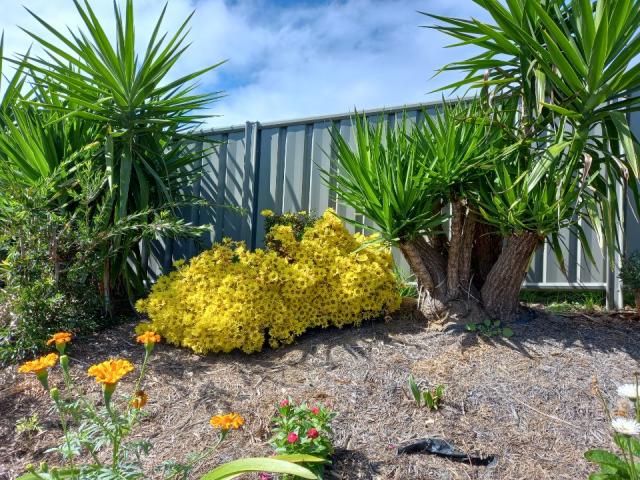By Beatrice Hawkins
Happy Mother’s Day to all mothers this weekend! In my case, every day is mothers day…even though they are widespread across this wonderful country I hear from all my family at least a few times a week and I know I am very spoilt in this.
At present, there are lots of Chrysanthemums, or “mums” as they are commonly known, in flower and my neighbour has a particularly beautiful golden yellow one in full flower in her lovely garden.
China seems to be the epicentre of varieties and there are an untold number of colours and forms that have been bred from the original plants occurring across most of Asia.
It is believed to have been cultivated in China as early as the 15th century BC as a herb and is preserved in pottery from that time. Obviously, with breeding, they have become larger and more spectacular.
The ancient Chinese name is “Chu” and there is “Chu Hsien” or Chrysanthemum City, named for the flower, in China.
Around the 8th century, it found its way to Japan and the Japanese became so enamoured of this beautiful flower that a single bloom was adopted as the crest and official seal of the Emperor. It was named the national flower of Japan in 910AD.
The highest order of chivalry in Japan is the Imperial Order of the Chrysanthemum and they also have a National Chrysanthemum Day that is called the Festival of Happiness.
They found their way to Europe in the 17th century but would hardly be recognised today as they were only a small yellow-flowered daisy. In 1753 Karl Linnaeus the Swedish botanist, combined the Greek words chrysos and anthemon, meaning gold and flower, to describe it.
Hybridisers around the world have produced the vast array of spectacular forms we enjoy today. There are 13 different classifications of form!
Given the time of year that they bloom here, they are a perfect choice as a mother’s day flower.
As a herb, it was believed to have the power of life and all parts were used to remedy various ailments. This is another reason they are very appropriate as the emblem for Mother’s Day!
In America they are known as the “Queen of the Fall”, the most widely grown pot plant and the largest commercially cultivated flower. They are hugely popular with florists as they have such a great variety of colour and form and are so long-lasting as a cut flower.
Europe doesn’t share this happy feeling for them apparently and they are often associated with death! In countries like Austria and Belgium, they are almost exclusively used as memorials on graves!
Generally, they symbolise longevity, joy, fidelity and optimism. Maybe it is the time of year that they flower.. in autumn before the onset of the extremes of the European winter.. that they have become associated with death in these climates. I much rather the association with joy and optimism!!
As I am still unable to drive myself about yet I really appreciate neighbours and friends that have been taking me places and I loved the flowers in Leslie Park as we drove by. The massed plantings in the garden beds looked beautiful. Congratulations to the council gardeners on their artistic plantings.
The weather has certainly turned cooler in recent days and my garden is showing it. All the leaves on my snail plant have gone as well as the grapevine. My garden has been severely neglected this year but somehow things like Sweet Alice and Vincas, Daylilies and Salvias still manage to provide colour and beauty.
Walking out the side of my house for the first time in ages last week I was pleased to see my Clematis is shooting well after the severe pruning a family member gave it in early March. It is in a protected spot so I should have a good show later in the year.
Planning is well underway for the Gardening Extravaganza to be held in St. Mary’s Hall in Wood Street on the Wednesday and Thursday of Jumpers and Jazz in July. The Horticultural Society provides the venue, so if you have garden-related items that you make or sell and would like to showcase them at the Extravaganza, feel free to contact me through the paper.







